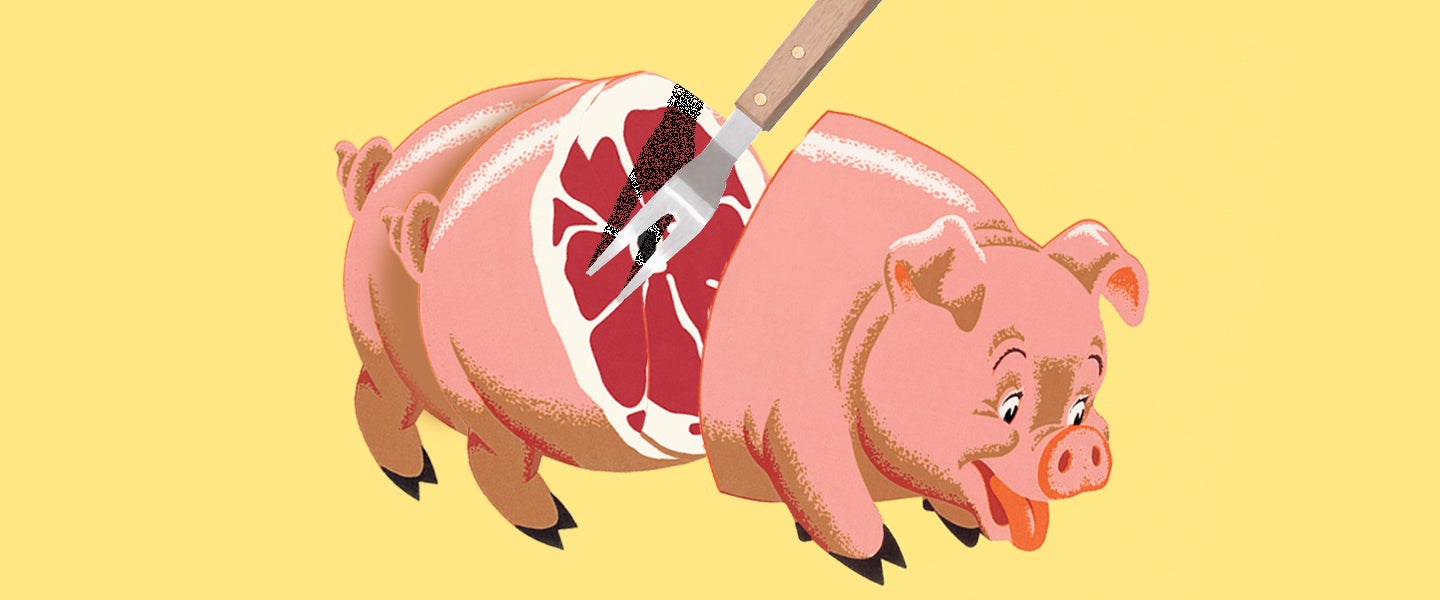Earlier this month, alt-right conspiracy lunatic Alex Jones got hangry enough on one of his InfoWars broadcasts to threaten to eat his neighbors. Playing to his followers’ fear of food shortages, he launched into a cannibalistic meltdown about one particular body part. “I’m starting to think about having to eat my neighbors. You think I like sizing up my neighbor, how I’m going to haul him up by chain and chop his ass up? I’ll do it,” Jones sputtered.
After name-checking his daughters to confirm that this would be ass-eating out of love, he went on to make it political (but of course): “I will eat your leftist ass like corn on the cob. I’m ready! I’ll barbecue your ass flat.”
As an un-voluptuous white woman, I’m comforted by the fact that Jones cannot flatten a curve that doesn’t exist. But his neighbors? They might want to look into some sort of butt-chastity belt until all of this blows over, because Jones further vowed to “hang your ass up and cut you into cutlets like a filet mignon and grill your ass before I watch my daughters starve to death.”
We’ve extensively investigated ass-eating in most sexual forms, but Jones has clearly put the rump roast before the rimming, which raises the question: What is it like to eat an actual gluteus maximus, the largest muscle and potentially most flavorful part of the body?
alex jones is gonna eat your ass
— Tyler Coates (@tylercoates) May 1, 2020
does alex jones read mel magazine, is that what happened
— Tyler Coates (@tylercoates) May 1, 2020
According to a very limited record of testimonials, human meat is typically compared to pork. Cannibals on the Marquesas Islands notoriously referred to it as “long pig.” Armin Meiwes, a German cannibal, said humans taste like pork, only “a little bit more bitter, stronger. It tastes quite good.” And early 20th century serial killers Fritz Haarmann and Karl Denke both claimed to sell their victims as “pork” at local markets.
Caleb Chen, a hunter and food blogger at The Highest Critic, speculates that while humans probably did taste like pork back then, after many generations of eating Doritos, there’s now a lot more meat on the bone. “A tongue-in-cheek answer would be that butt of a human would taste like ‘fat long pig,’” Chen tells me.
Other evidence suggests that human ass may be the darkest, reddest meat of all. That’s because the redness of meat is determined by how much myoglobin, a pigmented protein that turns muscle red, it has. Pork, lamb and beef average 2, 6 and 8 milligrams of myoglobin per gram of muscle, or a myoglobin concentration of 0.2 percent, 0.6 percent and 0.8 percent respectively; whereas chicken breast only has a concentration of about 0.05 percent, Texas A&M University’s Department of Animal Science reports. Humans, meanwhile, have a myoglobin concentration closer to 2 percent. Likewise, the most worked muscles in cows, pigs, and lamb tend to be the darkest and juiciest, and well, few body parts work harder than that ass.
“Butt cuts are generally the darkest meat available,” Chen says. “This means that they have less fat and also less saturated fat when compared with cuts from the front quarters or the back of an animal. Chemically, these darker cuts of meat have more iron because they have more myoglobin.”
That said, James Cole, an archaeologist at the University of Brighton who has studied cannibalism, argues that human thighs may be a better option when it comes to a high calorie return. That isn’t saying much, as his research shows humans are generally a poor food source next to other more socially acceptable animals. “In terms of calories, fat does give you the greatest return over protein so parts of the body that have a higher fat content, like the thighs, will give you more calories over leaner body parts, like biceps,” Cole explains.
His research shows that while the brain also offers a lot of calories, eating them comes with the risk of transferring neurodegenerative diseases. The Fore tribe in Papua New Guinea, which practiced funerary cannibalism — i.e., where people eat dead family members to free their spirits — experienced fatal kuru outbreaks.
Now, if there were a “healthier” form of cannibalism, it would easily be eating ass, but unsurprisingly, “logic isn’t what drives cannibalism in many cultures where it still exists,” Cole says. Rather, a complicated mix of cultural customs, rituals, criminal and psychotic behaviors, pseudoscience and war, all influence cannibalistic behaviors far more than what would make the best cut of beef.
Antonio Rodríguez-Hidalgo, an archaeologist at the Catalan Institute of Human Paleoecology and Social Evolution, does note, however, that when most people think of cannibalism, they think of it the way it’s portrayed in movies like Alive — for survival. And, he adds, “In cases of survival cannibalism, it’s often recorded that people start to eat from the ass.”
The more troubling reality about actually eating ass is that if most of us were to consume the hairy ham of a cow, pig or dude, we probably wouldn’t be able to tell the difference between them. Or as New York Times journalist William Seabrook put it when he cooked up and ate a hunk of human flesh in his 1931 book Jungle Ways, “It was so nearly like good, fully developed veal that I think no person with a palate of ordinary, normal sensitiveness could distinguish it from veal.”
If it’s that close to call, it might be time to truly give up meat, and send what’s left in my fridge to Jones in a Tupperware labeled “neighbors.”

